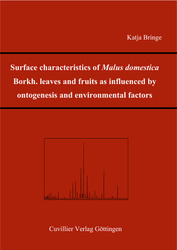| Fachbereiche | |
|---|---|
| Buchreihen (96) |
1378
|
| Nachhaltigkeit |
3
|
| Gesundheitswesen |
1
|
| Geisteswissenschaften |
2365
|
| Naturwissenschaften |
5406
|
| Mathematik | 229 |
| Informatik | 319 |
| Physik | 980 |
| Chemie | 1363 |
| Geowissenschaften | 131 |
| Humanmedizin | 243 |
| Zahn-, Mund- und Kieferheilkunde | 10 |
| Veterinärmedizin | 108 |
| Pharmazie | 147 |
| Biologie | 835 |
| Biochemie, Molekularbiologie, Gentechnologie | 121 |
| Biophysik | 25 |
| Ernährungs- und Haushaltswissenschaften | 45 |
| Land- und Agrarwissenschaften | 1004 |
| Forstwissenschaften | 201 |
| Gartenbauwissenschaft | 20 |
| Umweltforschung, Ökologie und Landespflege | 148 |
| Ingenieurwissenschaften |
1793
|
| Allgemein |
98
|
|
Leitlinien Unfallchirurgie
5. Auflage bestellen |
|
Erweiterte Suche
Surface characteristics of Malus domenistica Borkh. leaves and fruits as influenced by ontogenesis and environmental factors
Katja Bringe (Autor)Vorschau
Inhaltsverzeichnis, Datei (37 KB)
Leseprobe, Datei (110 KB)
In this study surface of apple leaves and fruits (M. domestica Borkh., `Golden Delicious`, `Topaz`) were characterised chemically and physically, in this context the influence of ontogenesis as well as environmental factors were considered. UV-B radiation and water stress served as model factors, allegorising environmental factors. UV-B radiation was provided by UV-B lamps with an intensity of 0.22 kW m-2 during periods of 0, 90 and 150 min. Water stress was induced by withholding water for two weeks. Chemical composition of surface wax was examined by means of GC-MS, while physical characteristics were described by measurement of contact angle and SEM studies. Retention and rainfastness of the applied fungicide mancozeb after the exposure to artificial UV-B radiation, and the penetration of CaCl2 through the isolated fruit cuticle were aspects investigated as well. During the ontogenetic development of apple seedling leaves the surface wax mass tended to decrease, and their chemical composition changed, whereas for each developmental stage a specific pattern of compounds was studied. The detected chemical groups were displayed by fatty acids, alcohols, alkanes, triterpenes and esters. From the physical point of view the adaxial apple leaf surface was characterised by an amorphous film of epicuticular waxes; surface exhibited a hydrophobic character, the flattening process during the course of studied time may be attributed to cell area expansion. For the first time extracellular α-tocopherol was detected by means of HPLC in the epicuticular wax. After influence of water deficit and UV-B irradiation, the chemical surface wax composition of adaxial apple leaves altered, as well as a changed morphology could be documented. Samples were studied 0, 24 and 48 h after irradiation with UV-B. The water deficit caused an increase in surface wax load of 30 %, being not exposed to UV-B. A statistical interaction could be detected only for the 24 h sampling time, therefor as well as UV-B as water deficit did excert an influence on cuticular wax mass. A slight rise in contact angle 48 h after the irradiation could be observed, signifying a decreased wettability compared to 0 and 24 h, sampling time influenced contact angle to a greater extent than tested environmental factors.
Retention and rainfastness (rain intensity 5 mm h-1, rain amount 5 mm) of the applied fungicide mancozeb by means of adaxial apple surface were documented. UV-B radiation was applied. Within the first 24 h after radiation the retention increased significantly, not changing within the following 24 h, whereupon the rainfastness was not influenced significantly. So far no studies were accomplished, documenting retention of mancozeb after exposure to enhanced UV-B radiation. Further the chemical composition changed as well. A slight increase in surface wax mass could be demonstrated. Changed wettability after irradiation could not be shown, in addition a flattenting process of the cuticle after treatment with UV-B is possible, accompanied by feasible change in leaf epidermis thickness.
The apple fruits (`Topaz`), which were grown under environmental conditions, whereas half of the samples were adapted to usual radiation and half were wrapped in UV-B impermeable film from june until harvest. After harvest, fruits (adapted/not adapted) were exposed to UV-B radiation; the chemical composition of the surface wax of enzymatically isolated fruit cuticle altered slightly, whereas mass changed dependent on adaption, this adaption was decisive as well for the penetration of CaCl2 through the cuticle, which changed. No correlation between was mass and Ca2+ – penetration could be established.
| ISBN-13 (Printausgabe) | 386727102X |
| ISBN-13 (Printausgabe) | 9783867271028 |
| ISBN-13 (E-Book) | 9783736921023 |
| Buchendformat | A5 |
| Sprache | Englisch |
| Seitenanzahl | 124 |
| Auflage | 1 |
| Band | 0 |
| Erscheinungsort | Göttingen |
| Promotionsort | Bonn |
| Erscheinungsdatum | 02.01.2007 |
| Allgemeine Einordnung | Dissertation |
| Fachbereiche |
Land- und Agrarwissenschaften
|








